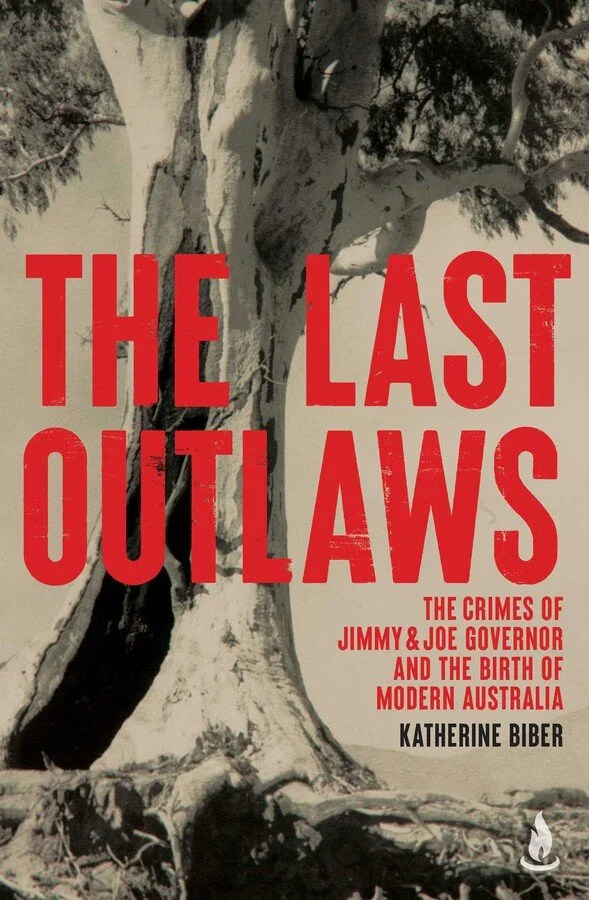THE LAST OUTLAWS: THE CRIMES OF JIMMY & JOE GOVERNOR AND THE BIRTH OF MODERN AUSTRALIA
…this is not just another book about bushrangers. It is not even a book about that small sub-set of bushrangers who were conferred with outlaw status. Instead, this is an extraordinary volume, written with empathy and expertise, that complicates our popular understandings of crime, punishment and the standard histories of Federation.
READ REVIEW
↓
THE LAST OUTLAWS: THE CRIMES OF JIMMY & JOE GOVERNOR AND THE BIRTH OF MODERN AUSTRALIA
Katherine Biber | 2025
Katherine Biber’s bold and brilliant new book, The Last Outlaws: The crimes of Jimmy & Joe Governor and the birth of modern Australia, is essentially a tale of villainy. This is an obvious point for anyone who is familiar with the Governor brothers and how these two Wiradjuri/Wonnarua men, Jimmy and Joe, sparked one of Australia’s greatest manhunts. What might surprise many readers—even those who feel they know these men and the events that became known as the Breelong Massacre—is that the murderers are not the greatest villains in this story.
A lot had happened in the Great South Land between the unloading of a cohort of convicts in Sydney Cove in 1788 to the establishment of a new nation in 1901. More specifically, a lot had happened to the Aboriginal peoples systematically dispossessed by colonists who, unsatisfied with just clinging to the coast, made their way across the continent and south to the island now known as Tasmania.
In her introduction, Biber articulates her aim to show how modern Australia ‘was made from the ruins of Indigenous dispossession, a penal colony, and an uncooperative assortment of colonial outposts in the far reaches of Empire’ (p. 4). In short, this is not just another book about bushrangers. It is not even a book about that small sub-set of bushrangers who were conferred with outlaw status. Instead, this is an extraordinary volume, written with empathy and expertise, that complicates our popular understandings of crime, punishment and the standard histories of Federation. The book’s title makes a bold claim linking the crimes of two men to ‘the birth of modern Australia’, but the book itself is an argument so compelling it will be difficult for most people who read this work to think about Federation without thinking about the Governor brothers.
With critical precision, Biber unpacks the events leading up to the Breelong Massacre, the legal machinations of the day, and the many ramifications of people predominantly following their own agendas. She summarises: ‘What Jimmy Governor wanted seems modest and reasonable: fair pay, dignity, humanity, solidarity’, and she challenges us to ‘reflect on what can happen when these are withheld’ (p. 240).
Biber’s prose is electric. She opens with the violence committed against the Mawbey family in the small New South Wales town of Breelong. In the aftermath, Ethel Governor gathers herself and her baby as she prepares to go on the run. Her husband, Jimmy Governor, ‘was a murderer, and her mind could not absorb this impossible new fact’ (p. 8). Ethel and Jimmy Governor, with Jimmy’s brother Joe, and their accomplice Jacky Underwood, abandon the Mawbey property. Ethel, with her baby Sidney, is sent to Dubbo by her husband but is captured almost immediately and taken into police custody. Underwood is also quickly apprehended: a lame man was never going to outrun the cops. With the relentless pace of a bestselling thriller, Biber takes us on a journey of what happened next and the chase that transfixed a set of colonies on the eve of nationhood.
Jimmy and Joe Governor were neither laden with an infant nor with an infirmity. Indeed, the manhunt for the Governor brothers was unlike any other. Mounted police, Aboriginal trackers and an army of volunteers lured by ideas of adventure and profit (the rewards made chasing these men a lucrative exercise), spent months in pursuit of Jimmy and Joe. Efforts to find the outlawed pair were fuelled by reports willingly submitted by members of the public and damning newspaper headlines. Another motivator was the fear of what the Governors would do next. This fear was realised because the murders committed at Breelong were not the last crimes these two men perpetrated.
It is easy to typecast a murderer as a villain, but if we muster all the wrongdoers in this case then the Governor brothers are not standing alone. There is the vulture of souls, the young, white missionary Retta Dixon. There are John and George Wilkinson, another pair of brothers, who took out Joe Governor. John, who fired the fatal shot, declared he ‘felt perfectly justified in taking the law into [his] own hands’ (p. 115). Perhaps unsurprisingly, ‘George’s evidence [bent] towards John’s in various respects’ (p. 115), with their versions of events merging over time. There are, too, men who saw these events as opportunities to fulfil personal aspirations as law enforcers, makers and practitioners. One of these lawmen was Bernhard Wise, Attorney-General, who pushed the machinery into motion to outlaw the Governor brothers: ‘Not one of his philosophical ideals was reflected in his decision, but Wise accepted that he simply didn’t care enough to stand his ground’ (p. 99).
Perhaps the worst players on this stage are those who fancied themselves as scientific intellectuals; the type who swapped human remains as easily as they might trade an unusual egg or a beautiful feather. There was Government Medical Officer Dr Alister Bowman who took Joe Governor’s brain while conducting his autopsy. Bowman would go on to gift this brain to James Wilson, who served as the Professor of Anatomy at The University of Sydney for three decades.
Professor James Wilson, The University of Sydney Archive
A well-regarded chap in his own day, Wilson's portrait, given full-page treatment in this book, has a distinct Professor James Moriarty vibe. Wilson ‘reasons that Joe Governor would do more service to the community in his death than in his life’ (p. 124). For Wilson, this stolen brain was just another specimen to try and justify nonsensical theories of racial inferiority that were rampant at the time. Interestingly, as Biber explains:
The role of science, and individual eminent scientists, is crucial to the story of the making of modern Australia, although the federation movement had not captivated the imagination of scientists. Instead, the scientists maintain tight links with the Empire, on the understanding that the colonies—and particularly the Australian colonies, with their distinctive flora, fauna and peoples—could bring innovation and experimentation to traditional imperial ideas. (p. 119)
Biber does not try to justify any of the violence that unfolded in 1900, but she does offer nuanced context that allows us to question the rights and wrongs of the crimes in addition to the rights and wrongs of the punishments applied: Joe shot in the Hunter Valley; Jimmy captured, tried, and ultimately hanged at Darlinghurst Gaol. In this way, the book can be quite confronting. The disasters wrought by colonialism, the fear of Indigenous reprisals, and the ambitions of those who saw themselves in some of the privileged positions that a new nation would offer. Moreover, never forgotten or glossed over, is the pain of the victims and their families.
To flawlessly integrate so many complex lines of history is quite an achievement. There have been numerous attempts over the years, with, ironically, some of the fictional pieces proving more powerful than their non-fiction counterparts. Yes, Biber has spent decades working with the relevant archival materials—and is responsible for an award-winning podcast of the same name—and she acknowledges how she has benefited from the guidance of descendants of the Governor men (the book is dedicated to Aunty Loretta Parsley). The idea of enough time and sufficient cultural connections being the only requirements to produce a book of this quality is, of course, absurd. This research demanded Biber’s expertise as a historian and legal scholar, it needed her meticulous approach to complex records, as well as her capacity to balance a national narrative with biographies of the famous, the forgotten, and the marginalised.
Historians rarely centre themselves in their own projects, but without Biber the messy threads of so many people’s lives would have remained tangled or have merely rehearsed some of the more superficial tellings of this story. I believe that The Last Outlaws is the most important book of 2025.
The Last Outlaws: The crimes of Jimmy & Joe Governor and the birth of modern Australia is published by Scribner Australia (an imprint of Simon & Schuster).
Reviewer: Rachel Franks, PHA (NSW & ACT)


